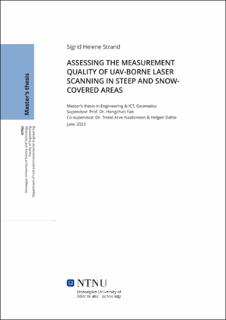| dc.description.abstract | Avalanche monitoring in the Norwegian mountains has great potential for preventing catastrophes, such as avalanches affecting public roads, and for informing hikers about dangerous paths. Using an unmanned aerial vehicle (UAV) borne laser scanner to collect point clouds in real-time for snow depth change detection can potentially be used to monitor avalanche risks. The remaining issue is to determine the quality of the point cloud data in steep and snow-covered areas. This thesis suggests a protocol for assessing the quality of the point cloud data and investigates the impact of key flight parameters, speed and altitude above ground level, on measurement accuracy. Roof models are utilised as control planes to emulate steep areas and for easy extraction of collected point for further error analysis. The real-time positions of the control planes are derived and a plane is constructed to be compared with the collection of points above and below the roof models. The distances of the points to the control planes are used to investigate the median and median absolute deviation. Further, the absolute distance is used to find the arithmetic mean, standard deviation and root mean square error of the distances. Lastly, inliers and plane equations are constructed from the UAV-collected point clouds using random sample consensus (RANSAC) segmentation for comparison with the dimensions of the roof model. The angle, volume and mid-point difference is calculated between the two plane equations from the boundaries of the bounding boxes. These parameters provide key insight into reliability of the point cloud data. The comparison reveals tangible position data and the impacts of flight speed and altitude on accuracy. Although varied flight speed shows no notable change in the error measures, the amount of points collected is significantly effected by both speed and altitude. Notably, point coverage is concentrated near the top of the roof models. As a result, the model volume calculated from the RANSAC-constructed plane that most closely matches the volume under the roof model is only 50% of the expectation: 0.030minstead of 0.060 m. The RANSACderived plane equations are compared with the roof model planes. The investigations of the inliers shows more points are collected above the roof model planes than under. The standard deviations of the inliers are between 0.011mand 0.023 m, and the root mean square error is between 0.060 m and 0.019 m. The investigations reveal clear indications of UAVs reliability for monitoring steep and snow-covered areas, without support from reference points to correct the positions. | en_US |

